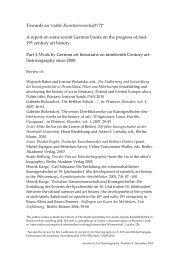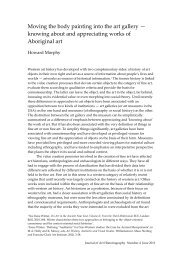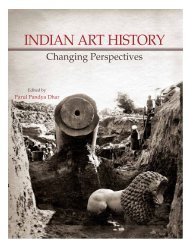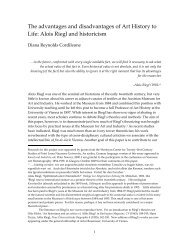9/CCG1 - Journal of Art Historiography
9/CCG1 - Journal of Art Historiography
9/CCG1 - Journal of Art Historiography
You also want an ePaper? Increase the reach of your titles
YUMPU automatically turns print PDFs into web optimized ePapers that Google loves.
Carolyn C. Guile<br />
Winckelmann in Poland: An Eighteenth-Century<br />
Response to the ‘History <strong>of</strong> the <strong>Art</strong> <strong>of</strong> Antiquity’<br />
Ancients’, he stated: ‘I allowed myself to give it the name ‘Polish Winckelmann’<br />
since, as most <strong>of</strong> the work is mine, I don't want to attribute new mistakes to<br />
Winckelmann…I would like to obtain a new honour for my nation in a branch <strong>of</strong><br />
literature previously untouched by it.’ 31 He argued that Winckelmann’s work was<br />
not really a history but rather a work that developed a system <strong>of</strong> ancient art – and<br />
therein resided the primary reason it captured his imagination and interest.<br />
The distinction between a history and a system also served as the basis <strong>of</strong> his<br />
engagement with the writings <strong>of</strong> Winckelmann’s critic, the pr<strong>of</strong>essor and classical<br />
philologist Christian Gottlob Heyne. Active in Göttingen during and after<br />
Winckelmann’s lifetime, Heyne proved a vocal if not inconsistent commentator on<br />
the value and importance <strong>of</strong> Winckelmann’s History to antiquarian studies. Heyne<br />
in his day had also been in contact with Adam Czartoryski, Potocki’s close associate<br />
and his wife’s uncle, and it is reasonable to assume that Potocki would have come to<br />
Heyne’s work both through academic and familiar means. Where on the one hand<br />
Heyne essentially praised Winckelmann’s History, he also attacked him for historical<br />
inaccuracies and an overly expressive, even dramatic writing style. Heyne’s reviews<br />
<strong>of</strong> Winckelmann appeared first in the 1760s while he was the editor <strong>of</strong> the<br />
Göttingische Gelehrte Anzeigen; they were at that point laudatory. 32 ‘Thanks to<br />
Winckelmann’, he wrote, ‘the knowledge <strong>of</strong> classic art among the general public has<br />
noticeably increased.’ 33 However, in the period 1771-81, when the Göttingische<br />
Gelehrte Anzeigen published reviews <strong>of</strong> translations and editions <strong>of</strong> Winckelmann’s<br />
letters, Heyne’s opinion <strong>of</strong> Winckelmann was much more negative, citing shaky<br />
conclusions and historical inaccuracies. 34 In some sense Heyne seems to have<br />
begrudged Winckelmann his success; he quipped that it was fortunate for the<br />
deceased that he did not have to live in his native land, and criticized him for<br />
snobbishness. 35 At that point in time, Heyne had become ‘perhaps [Winckelmann’s]<br />
severest critic’; his article, ‘Über die Künstlerepochen beym Plinius’ has been called<br />
‘the most devastating attack <strong>of</strong> the period upon Winckelmann’s scholarship and<br />
historical method.’ 36 Heyne had claimed that Winckelmann’s History, although a<br />
classic text, was riddled with historical inaccuracies, and uncharitably remarked<br />
that evidently Winckelmann felt himself above the painstaking work required for<br />
31 Pozwoliłem sobie dołączyć do niego imię Winkelmana polskiego, bo kiedy część wielka, że nie<br />
powiem większa pracy, którą publiczności przedstawiam, jest moją, nie chcę na Winkelmana narzucać<br />
obce jemu błedy, jeżeli w nie wpadłem, a w przeciwnem zdarzeniu pragnę zyskać dla narodu mojego<br />
nowy zaszczyt w gałęzi literatury, dotąd od niego nie tkniętej.’ Potocki, O Sztuce u Dawnych, 1: 23.<br />
32 See Henry Caraway Hatfield, Winckelmann and His German Critics, 1755-1781. A Prelude to the Classical<br />
Age, New York: King’s Crown Press, 1943, 32-3.<br />
33 Göttingische Gelehrte Anzeigen, 1768, 147 as quoted by Hatfield, Winckelmann and His German Critics,<br />
34.<br />
34 This point is made by Hatfield, Göttingische Gelehrte Anzeigen, 32-4 and 124 n.42, 126-8.<br />
35 Göttingische Gelehrte Anzeigen 1779, 6 and 1781, 661.<br />
36 Hatfield, Göttingische Gelehrte Anzeigen, 125. Christian Gottlob Heyne, Sammlung antiquarischer<br />
Aufsätze, 1, Leipzig: Weidmanns Erben und Reich, 1778-1779, 165-235.<br />
11
















